In April 2020, as the University migrated many services to an online setting, our IT Training Team embarked on a new adventure - delivering courses online via two IT Services: Microsoft Teams and Cisco Webex.
Both platforms have since experienced a huge uptake and new features are constantly being rolled out as the “Big Three” (Teams, Webex & Zoom) compete globally. Now as we are starting up 2021, we would like to reflect on our digital journey and share a few best practices.
As always, there rarely is a single best way to do something. We put together the following list based on experience and feedback from various stakeholders.
Feel free to use these strategies and sign-up for one of our various training and consultation sessions.
Note that this article has an online training focus; however these best practices can also be applied to meetings or presentation settings.
Happy New Year
and all the best in 2021!
- Dual screen setup
- Single screen setup
- Internet Quality
- Audio Setup
- Pedagogical considerations
- PowerPoint Tips
- Advanced Interactivity &
Resources
Using 2 monitors:
A real advantage.
When delivering a training session, it is highly recommended to use 2 monitors (the laptop screen -referred to here as screen 1- and a connected external monitor -referred to here as screen 2 - "the training screen"):
- The Browser and PowerPoint are delivered via screen 2;
- The chat session and participant lists are moved over to screen 1.
Display image

In this setup, it is recommended to only share screen 2 ("the training screen") with participants.
Use the following method to share screen 2 in Cisco Webex:
Display image
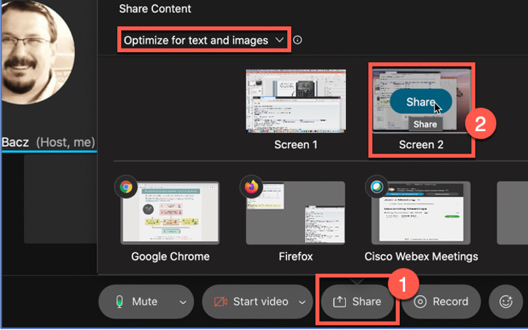
If you do not have access to another monitor, refer to the "Single screen setup" section.
Alternative setup - sharing an App
If you do not have access to another monitor, consider sharing an application instead of sharing your screen. You may for instance only share your PowerPoint application and Browser.
Display image
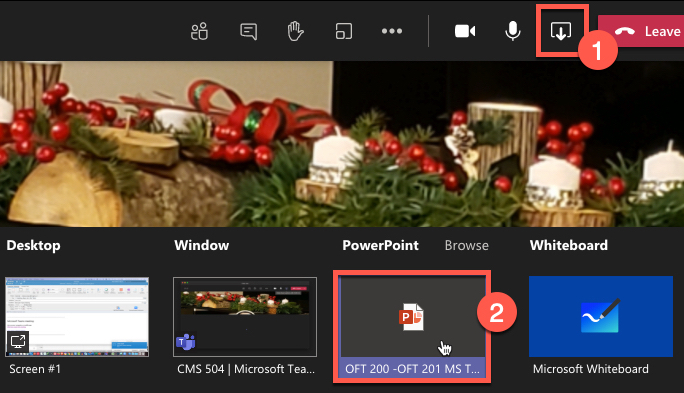
Sharing multimedia with your audience
If a YouTube video needs to be shared during the presentation you would need to re-share screen 2 using the “Optimize for motion and video” option. The “share your computer audio” box should also be checked.
Display image
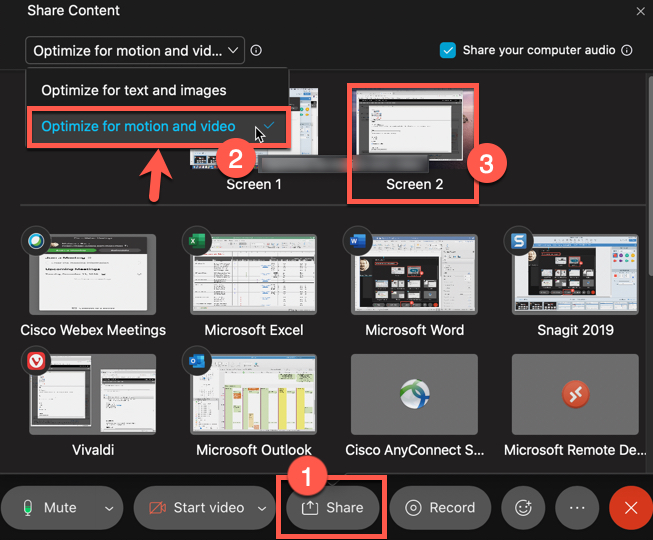
Note that using this option consumes more bandwidth hence once you have finished sharing your video you should switch back to the default share option.
Internet Quality
Participants connect to the training sessions using various Internet access options (cable, DSL, wireless, etc.). The quality of the Internet connection on their end can affect the session’s overall experience. These factors are largely out of our control.
However, we can provide some Internet access tips in our invitations.
I tend to add the following references in my invites:
Internet connection quality:
Be sure to have a good Internet connection. If using home WiFi, reduce the number of simultaneous users and be sure to be located within proximity of your home router.
Refer to the following article for additional support:
Note that running the McGill VPN can diminish your bandwidth and connection speed. If it’s not required in your training context, consider turning it off during the session.
Audio Setup
Some participants will occasionally have trouble accessing the session’s audio feed. If a participant does not have a laptop for instance, they may not have a Mic connected to their home computer.
This problem can easily be addressed by pointing out that they can join by “calling-in”. Each Webex invite, for instance, includes toll-free numbers that participants can call. They would then enter the meeting code to access the audio feed via their cell phone or landline.Display image
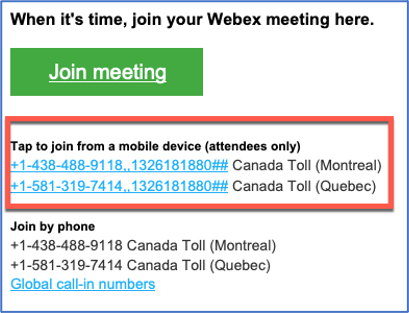
Hardware considerations
Using the default Mic on the laptop is not optimal. It will work but the sound quality is likely to be poor as if the speaker levels are high, it can create echo or other interference. Ideally participants should have a proper headset (with built-in noise cancellation) connected to their laptops.Display image

Hands-on Exercises
To simplify the online delivery process, try to build the exercises into your PowerPoint as much as possible. You then only need to worry about sharing the Browser and the PowerPoint.
Monitoring the Chat and Participant List
While delivering the session, you should always have the class chat session open. Some participants might not be willing to share their Mics but will interact with you via the chat session.
You should also monitor the participant list: Webcams (if they're on) for none verbal feedback; raised hands and/or feedback gestures.Display image
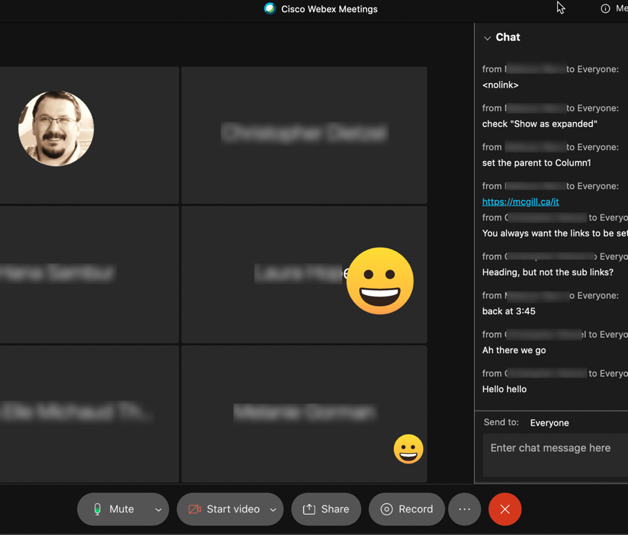
Raising your hand
Participants can easily "raise their hand" in a virtual setting. This feature mimics the classroom student concept we are all used to.
Display image
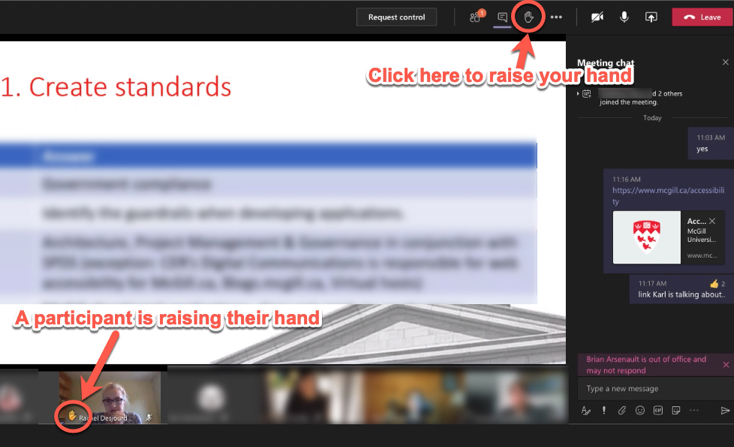
For advanced features such as Polling, refer to the Advanced Interactions & Resources section.
Using the Built-in Laser Pointer
The little known PowerPoint laser pointer can be used to successfully mimic the use of a traditional laser pointer in the classroom.
Display image

Using the Zoom Feature
Emphasize important elements within your presentation by adding a Zoom effect to crucial slides.
This feature could for instance be used to enhance the visibility of an element within a process map image.
Webex Polling
The Webex polling feature can be used to elicit a response from your audience. In a McGill website development session, for instance, it could be used to gather training requirements at the beginning of the session.
Possible polling questions:
- Does your site need to be bilingual?
- Which feature are you most interested in?
It could also be used in a formative evaluation context in the form of a mini-quiz to test comprehension.
Display image
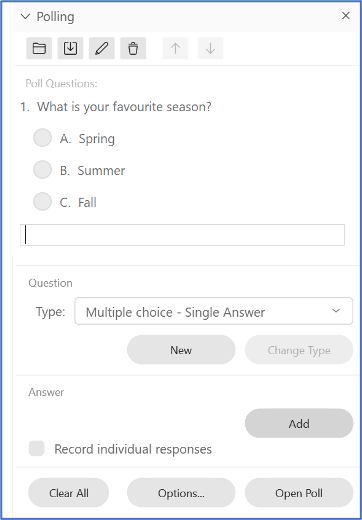
MS Teams participant screen-share
If your group is relatively small or if you are doing a one-on-one consultation, you can request the participant to share their screen with you.
Display image

Upcoming features..
Microsoft and Cisco are continuously upgrading their products. New features are rolled out to various organizations including McGill. McGill evaluates these features and customizes the offerings where needed.
Webex and more recently MS Teams added the useful breakout rooms feature which allows you to "break out" participants into sub-groups. This is meant to mimic an in-class situation where the instructor divides up the class into groups of students that are to work together on a given project during the lecture and in between classes.
Keep an eye out for new features being rolled out in 2021..
Additional Resources
- MS Teams
- Cisco Webex
- Zoom
Zoom is the official remote teaching tool for McGill academic courses.
For an in-depth coverage of Zoom, refer to the Teaching and Learning Services (TLS) website.

